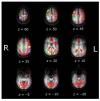Functional imaging reveals working memory and attention interact to produce the attentional blink
- PMID: 21568643
- PMCID: PMC3379570
- DOI: 10.1162/jocn_a_00054
Functional imaging reveals working memory and attention interact to produce the attentional blink
Abstract
If two centrally presented visual stimuli occur within approximately half a second of each other, the second target often fails to be reported correctly. This effect, called the attentional blink (AB; Raymond, J. E., Shapiro, K. L., & Arnell, K. M. Temporary suppression of visual processing in an RSVP task: An attentional blink? Journal of Experimental Psychology, Human Perception and Performance, 18, 849-860, 1992], has been attributed to a resource "bottleneck," likely arising as a failure of attention during encoding into or retrieval from visual working memory (WM). Here we present participants with a hybrid WM-AB study while they undergo fMRI to provide insight into the neural underpinnings of this bottleneck. Consistent with a WM-based bottleneck account, fronto-parietal brain areas exhibited a WM load-dependent modulation of neural responses during the AB task. These results are consistent with the view that WM and attention share a capacity-limited resource and provide insight into the neural structures that underlie resource allocation in tasks requiring joint use of WM and attention.
Figures





Similar articles
-
Attentional blinks as errors in temporal binding.Vision Res. 2007 Oct;47(23):2973-81. doi: 10.1016/j.visres.2007.06.022. Epub 2007 Sep 20. Vision Res. 2007. PMID: 17888482 Free PMC article.
-
The attentional blink reveals serial working memory encoding: evidence from virtual and human event-related potentials.J Cogn Neurosci. 2009 Mar;21(3):550-66. doi: 10.1162/jocn.2009.21036. J Cogn Neurosci. 2009. PMID: 18564042
-
Primary visual cortex reflects behavioral performance in the attentional blink.Neuroreport. 2008 Aug 27;19(13):1277-81. doi: 10.1097/WNR.0b013e32830bab02. Neuroreport. 2008. PMID: 18695507 Clinical Trial.
-
The interplay of attention and consciousness in visual search, attentional blink and working memory consolidation.Philos Trans R Soc Lond B Biol Sci. 2014 Mar 17;369(1641):20130215. doi: 10.1098/rstb.2013.0215. Print 2014 May 5. Philos Trans R Soc Lond B Biol Sci. 2014. PMID: 24639586 Free PMC article. Review.
-
Practice begets the second target: task repetition and the attentional blink effect.Prog Brain Res. 2009;176:123-34. doi: 10.1016/S0079-6123(09)17608-2. Prog Brain Res. 2009. PMID: 19733753 Review.
Cited by
-
No Evidence for an Auditory Attentional Blink for Voices Regardless of Musical Expertise.Front Psychol. 2020 Jan 10;10:2935. doi: 10.3389/fpsyg.2019.02935. eCollection 2019. Front Psychol. 2020. PMID: 31998190 Free PMC article.
-
Attentional Blink Effects on S-Cone Stimuli.Iperception. 2019 Feb 24;10(1):2041669519830103. doi: 10.1177/2041669519830103. eCollection 2019 Jan-Feb. Iperception. 2019. PMID: 30828417 Free PMC article.
-
Statistical learning as a tool for rehabilitation in spatial neglect.Front Hum Neurosci. 2013 May 29;7:224. doi: 10.3389/fnhum.2013.00224. eCollection 2013. Front Hum Neurosci. 2013. PMID: 23754998 Free PMC article.
-
Cross-Modal Decoding of Neural Patterns Associated with Working Memory: Evidence for Attention-Based Accounts of Working Memory.Cereb Cortex. 2016 Jan;26(1):166-79. doi: 10.1093/cercor/bhu189. Epub 2014 Aug 21. Cereb Cortex. 2016. PMID: 25146374 Free PMC article.
-
Abnormal Ventral and Dorsal Attention Network Activity during Single and Dual Target Detection in Schizophrenia.Front Psychol. 2016 Mar 8;7:323. doi: 10.3389/fpsyg.2016.00323. eCollection 2016. Front Psychol. 2016. PMID: 27014135 Free PMC article.
References
-
- Akyürek EG, Hommel B. Short-term memory and the attentional blink: Capacity versus content. Memory and Cognition. 2005;33:654–663. - PubMed
-
- Akyürek EG, Hommel B. Memory operations in rapid serial visual presentation. European Journal of Cognitive Psychology. 2006;18:520–536.
-
- Akyürek EG, Hommel B, Jolicœur P. Direct evidence for a role of working memory in the attentional blink. Memory and Cognition. 2007;35:621–627. - PubMed
-
- Akyürek EG, Leszczyński M, Schubö A. The temporal locus of the interaction between working memory consolidation and the attentional blink. Psychophysiology. 2010;47:1134–1141. - PubMed
Publication types
MeSH terms
Substances
Grants and funding
LinkOut - more resources
Full Text Sources

